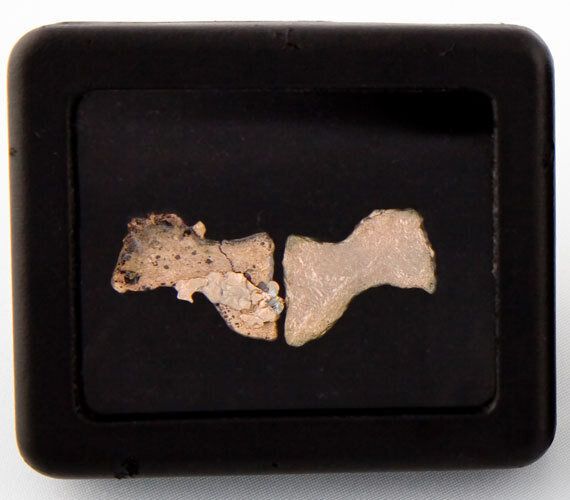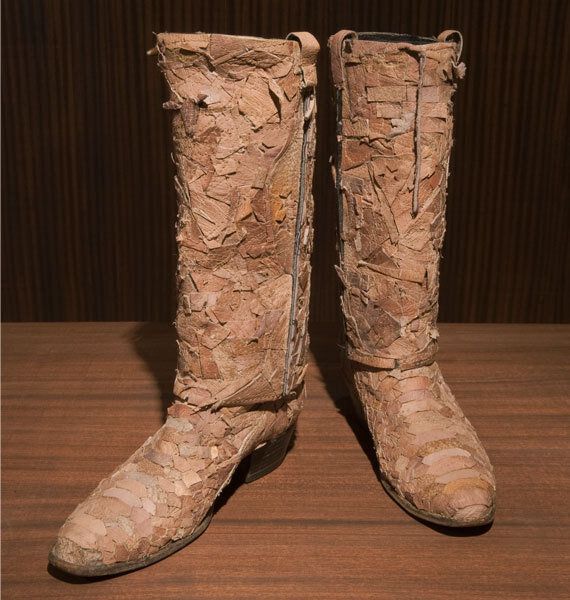I’m sat opposite a pair of boots. On a white plinth, in a gallery. They look like they’ve seen better days, a bit tatty around the edges. The stars and stripes pattern a little faded. But that’s not because they've been found somewhere - this piece of modern art is made from human skin.
The man in front of me has grown an ear on his arm through cell and tissue growth through biomaterials, it has, in time, grown its own blood vessels and become part of his body. On the wall behind him is a large print with three luminous sets of wings on - wings grown from pig cells which sit, in their smaller, duller, real form in a box nearby.
It’s easy to focus on the grisly at GV art gallery in Marylebone, London, but if you’re looking for an alternative to The London Dungeons you’ll be bitterly disappointed. Instead, the gallery has become an institute for exploring science’s interaction with art since it opened in 2008. Their most recent show, Trauma, brought together work from artists including Susan Aldworth, Katharine Dowson and Charlie Franklin with weekly lectures from scientists, artists and thinkers.

Oron Catts and Ionat Zurr's The Pig Wing Project
I’m here to listen to Stelarc and Joanna Zylinska discuss the ethics of bioart - the name given to art created from biological matter, which GV Art gallery specialises in exhibiting. Zylinska is a cultural theorist with a specialism in cyborgs, and she offloads a rapid artillery of philosophical debate. My brain hasn’t tried to process such information since university.
Stelarc is a performance artist, famed in the bioart sphere for producing groundbreaking work for decades. In 1980, he performed wearing nothing but a robotic arm, in The Third Hand. In Manhattan in 1984 he suspended himself, naked, on hooks two storeys above mystified crowds. Stelarc has put himself inside an exoskeleton of piston-operated armour and created a sculpture 40cm into his stomach cavity. In 2003 he created Prosthetic Head - a robot self-portrait with which humans can converse as it learns new information. Inside and out, he is a living, breathing, and surprisingly giggly cyborg.
Not that you would know this to look at him, dressed casually in a black jumper with smiling eyes. It takes an audience of 30 two hours to summon up the courage to ask him to show us his third ear, on the inside of his forearm, Stelarc’s most recent work and one still in construction. When complete, it will act as a WiFi-enabled transmitter, allowing him to “speak to someone on the phone through the ear, and hear the sound of their voice in [his] mouth.”
The point of this evening, however, is to place bioart within creative, scientific and philosophical spheres - not big tops. Bioart is as rooted in science as it is art, and it is this cross-over, or, as Zylinska brings to the discussion, “contamination” between the two which makes it so fascinating. It could be argued that it’s an artistic genre which brings to the fore more relevant and pressing questions about contemporary society than any other.

Shitkickers by Andrew Krasnow
The aforementioned boots, Andrew Krasnow's Shitkickers, are made from human tissue because it was the only medium the artist believed could convey the pain and suffering caused by extreme American nationalism and the conflict with the middle east experienced during George Bush’s presidency.
Other pieces, like Oron Catts and Ionat Zurr's The Pig Wing Project, explore how bioart seeks to understand the bigger questions surrounding existence. What is human life, what is natural, when are we playing God. How far removed, for example, is putting an extra ear on your arm from putting silicon implants in your breasts? Or wearing a hearing aid?
Bioartists do not have the same responsibilities as scientists - a point Zylinska returns to often - they are not making groundbreaking discoveries for the sole purpose of medical improvement. However, their proximity to science is essential. “Art should confuse us about science,” Zylinska says, “bioart is an important tester of moral hierarchies.”
Which is why the context behind bioart is so important. Without the knowledge that The Pig Wing Project is the creation of the first ever wing shaped objects grown using living pig tissue, the artifact itself could be a pork scratching.
And, of course, when an artist is relying so heavily on others’ knowledge to produce a work, a work which is as much biological experiment as it is creativity, are they really the ones responsible at all? Stelarc grins over his anecdote: “Apparently, in the operating theatre when my ear was being sewn on, the surgeons were overheard discussing it. One mused, ‘perhaps this is a work of art, but if it is, we must be the artists.’
GV Art London’s new show, Polymath, opens Thursday, 23 February and runs until 14 April.